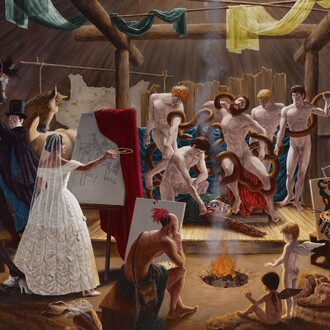Lois Andison’s multi-disciplinary practice displays a deep knowledge of transience. Through the use of sculpture, text, video and installation she conveys the complexity of time, systemic transformation and what it is that constitutes to be female in the canon of contemporary art history. Her work interrogates the hegemony of one of the many strains of history that views her as something extraneous to the patrilineal genetic line. This is a line Andison habitually steps across through her gestural, performative sculptures, her use of wordplay and through her afterworks.
A recurring motif in her kinetic sculptures is that of orbiting. This concept is extrapolated into word play that draws from the cycles of both the moon and the sun. The idea of time here is something which should not be thought of as linear but as a series of sequences running in synergy, through different zones of occurrence. It alludes to a more mindful and purposeful existence, one where we can move away from the ego, a traditionally male point of failure, and towards a more expanded sense of existence – a zone located in the inverse of the ego, a space of multiplicity that escapes framing by the masculine and allows for the conception of a third space, one which evolves from a history which evidently must change.
Her video work complements the noble simplicity and refinement of her sculptural work and bears the same depth in theoretical richness. Taking on the tradition of time, duration and the predominantly male-dominated area of impressionist painting, which sought to transfer to the canvas the neurological process the camera could not capture, Andison utilises technology, the same technology now synonymous with a culture obsessed with the documentation of the transient velocity, intensity and speed, and uses the gaze of the lens to conveys the movement a year – not a snapshot. Elsewhere in her moving images we encounter the performance of futility of the search for total control, a futility again that seems to allude the men at the helm of capitalism’s immaterial and abstract flows – like water flowing through the teeth of a comb, the unpredictability of financial black swans is something that cannot be controlled, though, and leads us to the conclusion that it is only what is outside of chance, our choices, that we can control.
To reiterate a comparison made in the catalogue of one of her exhibitions, Lois Andison’s work reveals the potential for empathy between engineering and aesthetics. Engineering in this sense is not just the design and physics of industry, but the re-harnessing of the development of what is considered natural in reigning biological norms. Engineering must take into account the injustices that take place in the name of a so-called natural order. Andison’s work is an aestheticising of this kind of causal creation – developing works that offer us epistemic enquiry as to what we are in the nexus of ideological infrastructures, and if there is room for us to act as collective agents towards our own determined trajectories.
Text by Terence Sharpe
















